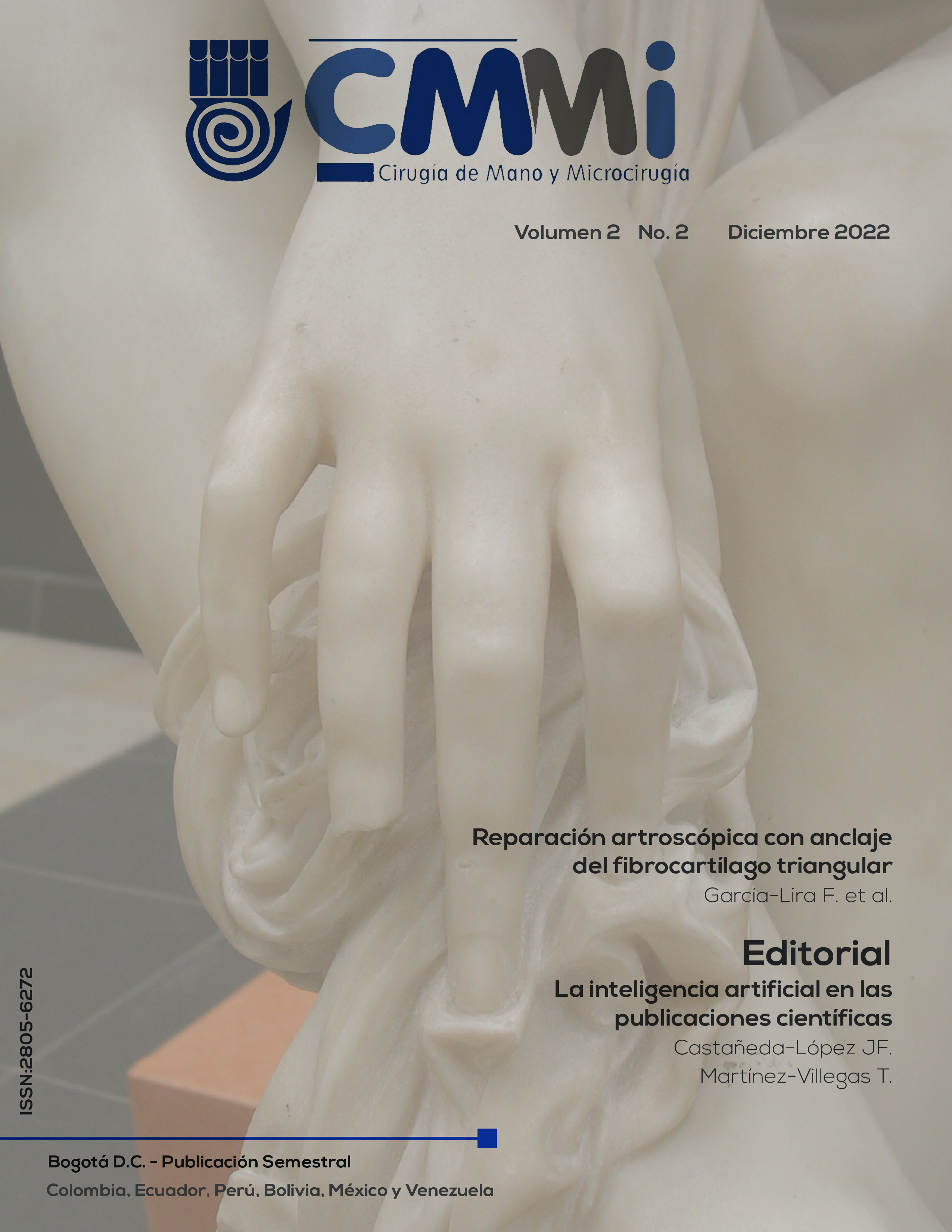Preliminary results with the Kessler-Tsuge knotless technique to Zone II Flexor Tendon lacerations: – a case series study
DOI:
https://doi.org/10.25214/28056272.1648Keywords:
Tendon Injuries, Suture Techniques, TendonsAbstract
Introduction : Flexor tendon injuries have an annual incidence of 33 x 100,000. Zone II lacerations account for the
most difficult to repair. There is no true consensus regarding a technique or the best suture material to be used. A strong
suture with a high tensile strength avoiding avascularity changes, provide the ability to expedite the rehabilitation
protocols. The goal of this study is to evaluate the results of the Kessler-Tsuge knotless technique.
Methods: Thirty patients with Zone II flexor tendon lacerations were included from 2017 to 2020 in this prospective
multicenter series of cases study. The Kessler-Tsuge knotless repair technique with 4-0 FiberLoop was used on all the
tendon lacerations.
Results: A total of 30 surgical procedures were performed with the described technique. Sixteen patients were lost
to final follow-up. The average age was 26 with a median of 20. The small and ring fingers were the most commonly
injured (57% and 35% respectively). Duran’s flexor tendon rehabilitation protocol was used. At the first month, the average
range of motion (ROM) was 65° PIP and 43° for the DIP joint and ROM of 92° PIP and 72.5° DIP joint at 3 third
month. The Visual Analogue Scale (VAS) for pain was 2 at 3 months. There were no any re-ruptures at final follow-up.
Discussion: kessler-Tsuge technique is a safe and reproducible technique that allows for a hidden knot at the A2
pulley level with a configuration of 4 core strands in two passes. Furthermore, it does not cause shortening of the
ends, provides a homogeneous and smooth bed for tendon gliding, allows for an expedite post-operative protocol, and
displayed good functional results at 3 months post- operative.
Downloads
References
de Jong JP, Nguyen JT, Sonnema AJ, Nguyen EC, Amadio PC, Moran SL. The Incidence of Acute Traumatic Tendon Injuries in the Hand and Wrist: A 10-Year Population-based Study. Clin Orthop Surg. 2014;6(2):196-202. DOI: 10.4055/cios.2014.6.2.196.
Tang JB, Amadio PC, Guimberteau JC, Guimberteau JC, Chang J, editores. Tendon Surgery of the Hand. Philadelphia: Elsevier; 2012.
Verdan CE. Half a century of flexor-tendon surgery. Current status and changing philosophies. J Bone Joint Surg Am. 1972;54(3):472-91.
Kleinert HE, Verdan C. Report of the Committee on Tendon Injuries (International Federation of Societies for Surgery of the Hand). J Hand Surg Am. 1983;8(5 Pt 2):794-8. DOI: 10.1016/ s0363-5023(83)80275-5.
Braga-Silva J, Kuyven CRM. Early active mobilization after flexor tendon repairs in zone two. Chir Main. 2005;24(3-4):165-8. DOI: 10.1016/j.main.2005.06.003.
Strickland JW. Development of flexor tendon surgery: Twentyfive years of progress. J Hand Surg Am. 2000;25(2):214-35. DOI: 10.1053/jhsu.2000.jhsu25a0214.
Tang JB, Xie RG. Biomechanics of core and peripheral tendon repairs. En: Tang JB, Amadio PC, Guimberteau JC, Chang J,
editores. Tendon surgery of the hand. Philadelphia: Elsevier; 2012. p. 35-48.
Corella F, Renner C, del Cerro M, Ocampos M. Técnica de sutura tendinosa «un paso, 4-hilos Kessler-Tsuge». Revista Iberoamericana de Cirugía de la Mano. 2015;43(2):122-7. DOI: 10.1016/j.ricma.2015.09.002.
Viinikainen A, Göransson H, Ryhänen J. Primary flexor tendon repair techniques. Scand J Surg. 2008;97(4):333-40. DOI: 10.1177/145749690809700410.
Choueka J, Heminger H, Mass DP. Cyclical testing of zone II flexor tendon repairs. J Hand Surg Am. 2000;25(6):1127-34. DOI: 10.1053/jhsu.2000.20155.
Lawrence TM, Davis TR. A biomechanical análisis of suture materials and their influence on a fourstrand flexor tendon repair. J Hand
Surg Am. 2005;30(4):836-41. DOI: 10.1016/j.jhsa.2005.03.011.
Bainbridge LC, Robertson C, Gillies D, Elliot D. A comparison of post-operative mobilization of flexor tendon repairs with “passive
flexion-active extension” and “controlled active motion” techniques. J Hand Surg Br. 1994;19(4):517-21. DOI: 10.1016/0266- 7681(94)90219-4.
Barrie KA, Tomak SL, Cholewicki J, Merrell GA, Wolfe SW. Effect of suture locking and suture caliber on fatigue strength of flexor tendon repairs. J Hand Surg Am. 2001;26(2):340-6. DOI: 10.1053/jhsu.2001.22926.
Renner C, Corella F, Fischer N. Biomechanical evaluation of 4- strand flexor tendon repair techniques, including a combined Kessler---Tsuge approach. J Hand Surg Am. 2015;40(2):229- 35. DOI: 10.1016/j.jhsa.2014.10.055.
Cao Y, Tang JB. Biomechanical evaluation of a four-strand modification of the tang method of tendon repair. J Hand Surg Br. 2005;30(4):374-8. DOI: 10.1016/j.jhsb.2005.04.003.
Downloads
Published
How to Cite
Issue
Section
| Article metrics | |
|---|---|
| Abstract views | |
| Galley vies | |
| PDF Views | |
| HTML views | |
| Other views | |





